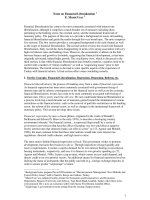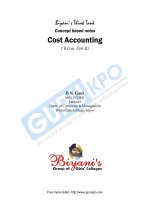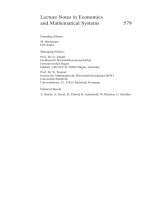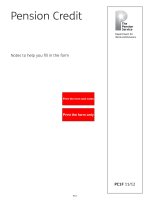M1 notes
Bạn đang xem bản rút gọn của tài liệu. Xem và tải ngay bản đầy đủ của tài liệu tại đây (17.9 MB, 86 trang )
Module 1
1
2
In this learning object we will learn:
The Foundation of Elliott Wave Theory
Basic Wave Patterns
Wave Characteristics
An Introduction of Mathematical Applications concerning Elliott Wave
Three Essential Rules that must never be broken
Labeling of Waves and how to plot them on your charts
At the end of this module, there will be a quiz.
3
Ralph Nelson Elliott developed the Elliott Wave Theory in the 1930’s by studying
various market indices spanning over a 75-year period. He discovered that stock
markets, thought to behave in a somewhat chaotic manner, in fact, did not.
They traded in repetitive cycles, which he discovered were the emotions of
investors as a cause of outside influences, or predominant psychology of the
masses at the time.
Elliott stated that the upward and downward swings of the mass psychology always
showed up in the same repetitive patterns, which were then divided into patterns he
termed “waves.”
4
Subsequently, many other Elliott Wave theorists have applied his principles to
markets other than stocks, such as Forex and commodities, with great success.
This is to say that the theory is transferable to virtually all traded markets.
5
Elliott’s work was published in 1938 in a monograph titled The Wave Principle,
which has come to be known as the Elliott Wave Principle. He tied these patterns of
collective human behavior to the Fibonacci sequence, or golden ratio, well known by
mathematicians and scientists. There will be more on Fibonacci later in this and
following modules.
6
In 1953, A. Hamilton Bolton, the founder of the Bank Credit Analyst, published the
Elliott Wave Supplement. This annual report was published for the next 14 years
until his death,…
7
at which point A.J. Frost, in collaboration with Robert Prechter, took over the
supplements. In 1978, together they wrote the Elliott Wave Principle, considered
one of the definitive textbooks on wave theory. Prechter further published several
other books on Elliott and his principles.
8
This illustration reflects the Wave Principle, which is that in any market cycle, waves
will subdivide until a complete market cycle is established. As the market unfolds in
repetitive wave forms, which are governed by man’s social nature, they have
predictive value. Waves are patterns of directional movement. Since a wave is any
one of the patterns that naturally occur, when we learn these patterns, which is the
subject of this course, we will be more apt to recognize market movement as it
occurs.
9
MARKET CYCLE
One complete cycle consists of eight waves. To start, a movement will unfold in its
primary direction in a series of 5 waves, labeled 1 through 5. This 5-wave impulsive
sequence is also called a motive wave or simply a “five.” The 5-wave pattern is
followed by a 3-wave corrective sequence, also called a “three.” The impulsive
sequence is numbered 1 through 5, and the corrective sequence is labeled A-B-C.
In this example, the A-B-C sequence corrects the 1-2-3-4-5 sequence. Another way
of saying this is, at any time a price in the market moves in the direction of the
larger trend, it will form a 5-wave sequence followed by a 3-wave sequence which
moves against or corrects the trend.
This type of movement also creates the necessary environment for progress in
either an upward or downward direction.
10
Fractals are self-similar patterns composed of smaller copies of themselves ad
infinitum. It is often associated with recursive operations on shapes or sets of
numbers, in which the result of the operation is used as the input to the same
operation, repeating the process indefinitely.
11
The Science of Chaos, and specifically fractal analysis, became popular 50 years
after Elliott concluded that the progress of the market was fractal in nature by
discerning patterns that are repetitive in form. Elliott isolated these patterns, or
waves that recur in market price data. These fractal forms—complex shapes which
look more or less the same at a wide variety of scale factors, are everywhere in
nature. Fractals are found from the coastlines of continents to the courses of rivers,
clouds in the sky, branches of plants and veins in their leaves. These fractals, which
are self-similar or self-identical patterns, abound. A fractal is a geometric structure
that is self-similar when scaled.
12
A branch of a tree is often used as an example. The branch is similar to the whole
tree, and if you break a twig off the branch, the twig is similar to the branch. In a
true, mathematical fractal, this scaling goes on forever. Fractals become clear when
we look at occurrences in nature.
13
Examples of fractals in nature are cauliflower…
14
Romanesco broccoli…
15
and the Fern.
16
Market movements reflect mass human psychology. These movements form
patterns that predict market behavior. Elliott named and characterized these
patterns or waves he found in the market data. He also described how they link
together to form larger versions of themselves, and then link to form the same
patterns at the next larger level. When behavior looks similar at various scales of
resolution, it is said to be fractal. Elliott Waves are fractal with waves embedded
within waves, within waves, etc.
17
For example, have you ever looked at a chart and could not readily determine if
they were hourly, daily, weekly, or monthly bars or candlesticks?
Look at the chart visual here. This chart could easily be a 15-minute, hourly, daily or
monthly chart, when in fact it is a weekly. These replicating wave structures produce
a progression of patterns which Elliott called the Wave Principle.
18
The fractal nature of markets means that patterns repeat themselves in different
time frames.
Waves of any degree in any series are made up of waves of lesser degree.
19
Just as nature reproduces in the same patterns of different degrees, so too do
market patterns.
Notice this 5-wave sequence subdividing into waves of a lesser degree, found in a
smaller time frame.
Whether a monthly, weekly, daily, 4-hourly, hourly, or 15-minute chart, the patterns
repeat themselves.
This enables one to trade any time frame using the Elliott Wave Principle.
20
The basic 5-wave structure in a rising market or uptrend consists of three upward
movements that are intermediated by two downward movements. This 5 wave
structure is termed “motive.”
Waves 1, 3, and 5 are called impulsive or motive waves and move in the direction of
the trend, and in this example, an uptrend, they are rising waves. Waves 2 and 4
are called corrective waves and are countertrend interruptions, moving against the
trend. This is the basic 5-wave count.
21
Then it is followed by the basic 3-wave structure consisting of two downward
movements that is intermediated by one upward movement, termed
“corrective.” The correction is lettered A-B-C.
A 5-wave advance or decline is followed by a 3-wave move in the opposite
direction. The basic rhythm is five waves corrected by three waves, no matter
what time frame is being looked at. We call the A-B-C pattern the corrective
sequence. The 5-wave advance is the numbered phase and the 3-wave
correction is the lettered phase. This sequence remains constant no matter
what degree of wave is being analyzed.
22
The basic 5-wave structure in a falling market or down trend will repeat itself in the
opposite direction when a complete cycle occurs. As such a downward wave
structure will consist of three downward movements that are intermediated by two
upward movements. Just as in an uptrend a complete 5-wave pattern moving
downward is termed “impulsive or “motive.”
23
Then it is followed by the basic 3-wave structure consisting of two upward
movements that is intermediated by one downward movement, termed
“corrective.” The correction is lettered A-B-C.
24
In an uptrend or rising market the impulsive wave moves with the predominant
uptrend. The corrective wave moves against the predominant uptrend.
25









